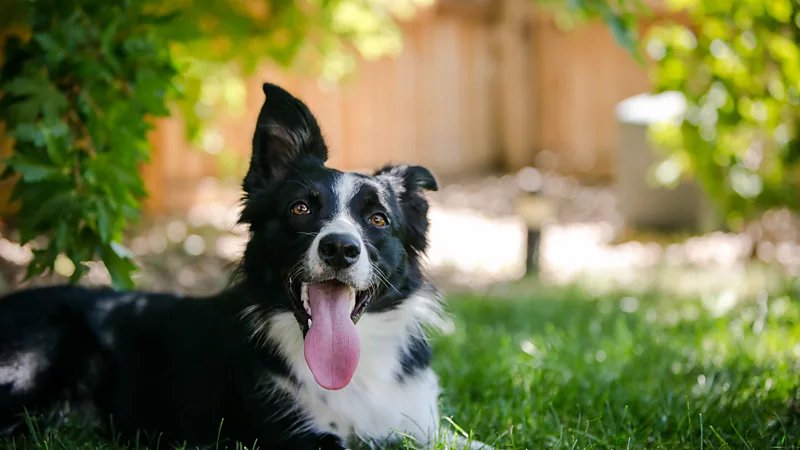How to keep dogs cool in hot weather
From burnt paws to heatstroke, dogs and other pets can suffer in the heat. Here's how veterinarians recommend keeping them cool.

As heatwaves break out this summer, many pet parents may become concerned about their companions. Our pups may eagerly join us on a sunny trip to the park, but they can have a hard time cooling off and can sustain heat injuries even when temperatures may not feel very hot to humans.
While some other pets, such as cats, generally fare better when it comes to avoiding overheating, they can be at risk of too much Sun too.
That said, it's possible for pets to enjoy time outside safely in the summer. Here's what experts recommend for keeping dogs and cats safe from the dangers of the heat.
Watch out for sudden temperature rises
Heatwaves around the world are becoming longer and more intense due to climate change. But even when the weather isn't blazing hot, pets can get heat injuries, catching owners off guard. Veterinarians say they often see a spike in heat injuries in dogs during late spring. "We can start seeing heatstroke pretty early, even if the weather itself isn't extraordinarily hot," says veterinarian Amanda Cavanagh, who leads urgent care services at the Colorado State University veterinary hospital.
Pet dogs often suffer heat injuries in late spring or early summer for two reasons: their physical fitness is down and they are not acclimatised to the heat. Some owners reduce walks during the colder months, says Katherine Farrell, an emergency and critical care veterinary specialist at the University of California, Davis. Then, when the days warm up, they are eager to take their dogs for a long hike, which can expose them to excessive heat. "They didn't anticipate the weather and their pet is not in that great of shape," says Farrell.
Canines can be conditioned to endure the heat, with military and police dogs often working through the summer heat, notes Cavanagh. But those German Shepherds and Belgian Malinois are exercised throughout the year, maintaining peak physical fitness.
Consider your pet's risk factors
Some dogs are poorly equipped to shed heat. You might be picturing a fluffy Samoyed, but they are not the worst-suited to the summer. Instead, squish-faced or brachycephalic breeds, such as bulldogs, French bulldogs and pugs top the list of dogs most likely to suffer in the Sun. One study found these canines had a risk of heat illness more than four times higher than dogs with longer snouts.
Their short snouts are to blame. Dogs mainly get rid of heat through panting, which moves heat out of their airways and into the environment, explains Cavanagh. The water vapour from their respiratory system evaporates, producing a cooling effect. (While dogs can sweat through their paws, this is of minimal significance for cooling, says Farrell).
"When you open up the mouth of a German Shepherd or a Labrador, you can see right down into their airway," says Cavanagh. "If you open the mouth of a bulldog, all you'll see is a giant tongue and a big soft palate, and it just looks like jowls and tissue back there."
That means they can't open up their airway and get rid of heat. "Having an obstructed airway from being a squishy-face breed is really the highest risk factor," adds Cavanagh.
For some dog breeds, a trip to the groomers may help with heat tolerance, as taking off extra length their coats can help them shed heat more easily, says Farrell.
But always consult your veterinarian for advice on what's best for your dog. While long coats may be warmer, they are more functional than they seem. A double coat, with short hairs beneath a layer of long fur, can insulate a pet from the heat, provided it's well-groomed and free of mats, says Cavanagh. For dogs with these thick double coats, including huskies and malamutes, the insulation they provide works better if the coat is left intact – meaning a shave can actually make them more vulnerable to overheating, says Farrell.
All dog breeds, as well as other furry animals like cats, will benefit from regular brushing to prevent build-up of fur and matting, allowing better airflow and cooling.
Overweight pets are also at greater risk of overheating, adds Farrell (it's estimated that over half of dogs and cats in the US are overweight or obese). Certain medicines can also reduce pets' ability to tolerate heat, she adds.
Go outside prepared
When the weather warms, start with shorter walks and don't push your dog if they are panting heavily: allow them a few weeks to acclimatise to warmer temperatures.
In hot weather it's safer to keep your outings to the early morning and evening, avoiding the middle part of the day. (Read about the science-backed ways to keep yourself cool in a heatwave too). During the midday heat, your pet may not be able to shed the heat they are producing through exercise, leading to a risk of overheating, says Cavanagh.
In general, pets can overheat at air temperatures over about 77F (25C), and this risk is far greater when humidity is over 65%, says Ronald Li, an emergency and critical care veterinary specialist at North Carolina State University. "High humidity in the air negates the ability of dogs to cool down by panting," he says, as the humid air reduces evaporation from the dog's tongue.
Don't leave your pet in the car or any other enclosed space that could easily heat up to dangerous temperatures, adds Cavanagh. Even on a mild, 70F (21C) day, the temperature in a car can climb almost 20F (11C) in just 10 minutes. Conservatories, sunrooms and caravans can pose a similar risk to both dogs and cats. And outdoor cats looking for a warm spot can end up trapped in overheated sheds and greenhouses, so make sure to check them before locking up.
When you do take your dog out, carry water for them and seek shadier spots. Lapping up some water outside recoups water lost through panting and reduces the chance they will guzzle their whole bowl when they get home, which can increase the risk of bloat, a potentially life-threatening condition, says Cavanagh.
And remember to check pavement temperatures. While the pads on dogs' feet may seem tough, they can still suffer burns from hot surfaces, says Farrell, who has seen burned paws in canine patients from walking on a hot pavement. If you can't hold your hand on the ground for 30 seconds, chances are it could burn your pet's paws, she says. Try to stick to places where your pet can walk on cooler surfaces like grass or dirt.
Choose heat gear wisely
If you can't avoid walking on hot pavements, outfitting your dog's paws with boots can help, says Farrell. Be sure to find a good fit, however – ill-fitting ones can create sores on their feet and ankles, adds Cavanagh.
Some pet companies market "cooling vests" designed to cool dogs through evaporation. There is some evidence in military working dogs that these vests can cool down canines – at least during a short bout of physical activity. But Cavanagh cautions that the effect doesn't last long: "They work for the first 10 minutes as they absorb all your heat, and then they're like this hot, wet blanket on top of you."
If your pet has a pink nose or sparse fur, they might benefit from a coat of children's sunscreen in those areas, says Cavanagh. Cats tend to get skin cancer on their less furry parts such as their ear tips and noses, she says, so sunscreen may benefit pets that like to sunbathe, such as felines that sun themselves by windows.
Spot the signs of overheating
One of the earliest signs of overheating in dogs is heavy panting beyond what your pet normally sounds like after some zoomies on a cooler day, says Farrell. Noisier breathing, with snoring or high-pitched sounds, is especially concerning – it could mean the airway is swelling and having difficulty dissipating heat. Cats may also start to breathe with their mouth open when they're too hot or otherwise need medical attention, added Farrell.
Heatstroke sets in when the body temperature becomes dangerously elevated; in canines, that cut off is generally above 105.8F (41C). When pets get this hot, the nervous system is affected, and you might see them appear disorientated or weak and wobbly, says Cavanagh. In dogs, pink gums turn bright red during heat stroke, she adds.
If you see these signs of heatstroke, bring your pet to a veterinarian. If the clinic is more than 10 to 15 minutes journey away, it can help to cool them down at home first, says Farrell – the faster you can bring their temperature down, the lower the risk of serious injuries. A splash of cool water is your best bet – in fact, one 2024 study found that voluntary head dunking in water (by dogs trained to do this by themselves) is more effective than wearing ice packs or wet towels. Hose your pet down with cool water, or dunk them in the bathtub, and run a fan across their wet fur, recommends Farrell.
Still, be careful with very cold water or ice, which can cause blood vessels to get smaller, reducing heat dissipation from the body, says Farrell. "Wide open blood vessels help dissipate heat."
It's important to take action if you think your pet is overheating. Heatstroke can lead to kidney injuries, bruising and internal bleeding, and brain injuries, says Cavanagh. She has seen dogs with heatstroke hospitalised for days to weeks, and many need blood transfusions. "The biggest challenge with heat stroke is not necessarily cooling the animal back down," says Cavanagh. "Being hot can have consequences to all of the organs."
The vast majority of pets Cavanagh and Farrell see for heatstroke are dogs. "Cats often times don't get heatstroke from being outside or exercising too vigorously because they're kind of smarter than that," says Cavanagh. "They won't run themselves into a heat stroke episode like our Labradors will." Both mentioned, however, that they occasionally treat felines who have suffered heat stroke from getting trapped in the dryer – a risk to be aware of for the heat-loving creatures.
Eager to be at our sides, our canine companions will endure the heat even when it's a risk to their health. It's up to us to prepare them for warm outings and to be on the lookout for signs of overheating.
-BBC







